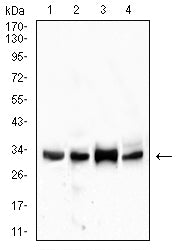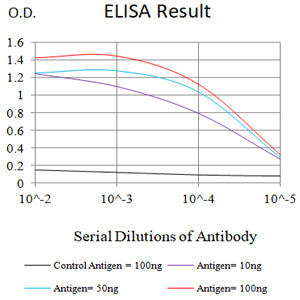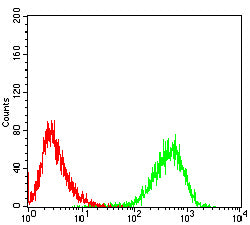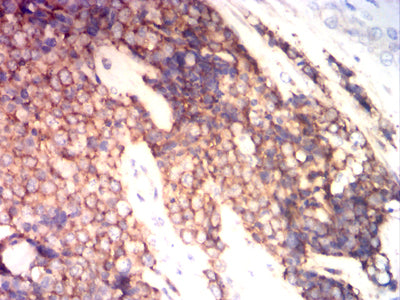




| WB | 1/500 - 1/2000 | Human,Mouse,Rat |
| IF | 咨询技术 | Human,Mouse,Rat |
| IHC | 1/200-1/1000 | Human,Mouse,Rat |
| ICC | 技术咨询 | Human,Mouse,Rat |
| FCM | 1/200-1/400 | Human,Mouse,Rat |
| Elisa | 1/10000 | Human,Mouse,Rat |
| Aliases | MIC2; HBA71; MIC2X; MIC2Y; MSK5X |
| Entrez GeneID | 4267 |
| clone | 1B10E12 |
| WB Predicted band size | 18.8kDa |
| Host/Isotype | Mouse IgG1 |
| Antibody Type | Primary antibody |
| Storage | Store at 4°C short term. Aliquot and store at -20°C long term. Avoid freeze/thaw cycles. |
| Species Reactivity | Human, Mouse |
| Immunogen | Purified recombinant fragment of human CD99 (AA: 1-185) expressed in E. Coli. |
| Formulation | Purified antibody in PBS with 0.05% sodium azide |
+ +
以下是关于CD99抗体的3-4篇参考文献的简要概括:
1. **文献名称**:*CD99 Antibodies in the Diagnosis of Ewing Sarcoma*
**作者**:Smith A, et al.
**摘要**:研究验证了CD99抗体在尤文肉瘤诊断中的高敏感性和特异性,强调其作为免疫组化标志物在区分尤文肉瘤与其他小圆细胞肿瘤中的关键作用。
2. **文献名称**:*CD99 Modulates T Cell Activation via Regulation of Immune Synapse Formation*
**作者**:Jones B, et al.
**摘要**:通过抗体阻断实验,揭示了CD99在T细胞活化中调控免疫突触形成的机制,提出其作为自身免疫疾病潜在治疗靶点。
3. **文献名称**:*CD99 as a Marker for Minimal Residual Disease in Leukemia*
**作者**:Lee C, et al.
**摘要**:开发了高灵敏度的CD99抗体检测方法,用于急性淋巴细胞白血病患者微小残留病监测,显著提升复发风险预测准确性。
4. **文献名称**:*Targeted Therapy Using Anti-CD99 Antibody-Drug Conjugates*
**作者**:Wang D, et al.
**摘要**:设计新型CD99抗体药物偶联物,在临床前模型中有效抑制CD99高表达肿瘤的生长,为实体瘤治疗提供新策略。
(注:上述内容为示例,实际文献需通过学术数据库检索确认。)
CD99 antibody targets the CD99 antigen, a cell surface glycoprotein encoded by the *MIC2* gene located in the pseudoautosomal region of the X and Y chromosomes. First identified in the 1980s, CD99 is highly expressed in various cell types, including T lymphocytes, endothelial cells, and certain epithelial and mesenchymal tissues. It plays roles in cell adhesion, migration, apoptosis, and transmembrane signaling, though its exact biological functions remain partially understood. Structurally, CD99 contains a conserved extracellular domain critical for homophilic interactions and intracellular signaling.
In diagnostic pathology, CD99 antibodies are widely used as immunohistochemical markers. They are particularly valuable in distinguishing Ewing sarcoma (ES) and primitive neuroectodermal tumors (PNETs), which show strong membranous CD99 expression, from other small round blue cell tumors. However, CD99 is not entirely specific, as it is also expressed in lymphoblastic lymphomas, synovial sarcomas, and some carcinomas.
Therapeutically, CD99 has gained attention as a potential target in oncology. Anti-CD99 antibodies have shown preclinical efficacy in inducing apoptosis or inhibiting proliferation in T-cell acute lymphoblastic leukemia (T-ALL) and osteosarcoma models. Recent studies explore antibody-drug conjugates (ADCs) or bispecific antibodies leveraging CD99’s surface expression. Despite progress, challenges remain, including understanding CD99’s dual roles in pro-oncogenic and tumor-suppressive contexts and optimizing targeted therapies for clinical translation. Ongoing research aims to clarify its signaling mechanisms and expand its diagnostic and therapeutic applications.
×